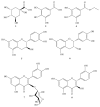Analgesic, Anti-Inflammatory, and Antioxidant Activities of Byrsonima duckeana W. R. Anderson (Malpighiaceae)
- PMID: 28367492
- PMCID: PMC5358439
- DOI: 10.1155/2017/8367042
Analgesic, Anti-Inflammatory, and Antioxidant Activities of Byrsonima duckeana W. R. Anderson (Malpighiaceae)
Abstract
Background. Byrsonima is a promising neotropical genus, rich in flavonoids and triterpenes, with several proven pharmacological properties. Nevertheless, Byrsonima duckeana W. R. Anderson is an Amazonian species almost not studied. Objective. To assess the antioxidant, anti-inflammatory, and analgesic activities of Byrsonima duckeana leaves. Materials and Methods. We analyzed an ethanol extract and its fractions for polyphenol content and UHPLC-MS/MS, phosphomolybdenum, DPPH, TBARS antioxidant tests, formalin-induced pain, carrageenan-induced peritonitis, acetic acid-induced abdominal writhings, and hot plate assays. Results. All the samples showed high polyphenol content and antioxidant capacity in the phosphomolybdenum, DPPH, and TBARS tests. We identified ethyl gallate, quinic acid, gallic acid, catechin, epicatechin, quercetrin, and quercetin in the samples. B. duckeana was able to reduce leukocyte migration in the carrageenan-induced peritonitis by 43% and the licking time in the formalin test by 57%. In the acetic acid-induced writhing test, the chloroform (FCL) and ethyl acetate (FEA) fractions were the most active samples. FEA was selected for the hot plate test, where all the dosages tested (5, 50, and 200 mg·kg-1) showed significant analgesic activity. Conclusion. B. duckeana has interesting analgesic and antioxidant activities, due to its high phenolic content, especially phenolic acids.
Conflict of interest statement
The authors declare that they do not have conflict of interests.
Figures





References
-
- Ruviaro L. F., Filippin L. I. Prevalence of chronic pain in a Basic Health Unit of a middle-sized city. Revista Dor. 2012;13(2):128–131. doi: 10.1590/s1806-00132012000200006. - DOI
Publication types
MeSH terms
Substances
LinkOut - more resources
Full Text Sources
Other Literature Sources

